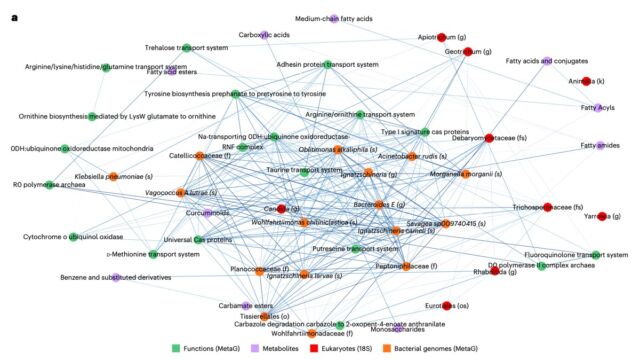[ad_1]

Establishing a exact time of demise (the postmortem interval, or PMI) upon discovery of a corpse is notoriously difficult, nonetheless simple fictional health workers would possibly make it appear. Some forensic scientists use the life cycle of blow flies, which hunt down and lay eggs on corpses. However there’s plenty of variability between fly species and seasonal results, so it could be useful to develop new strategies.
It seems that learning the microbes that flourish in decomposing corpses can present useful clues. Forensic scientists have now recognized some 20 microbes they consider represent a form of common community driving the decomposition of lifeless animal flesh, in accordance with a brand new paper printed within the journal Nature Microbiology.
“One of many principal questions of any demise investigation is ‘when did this individual die?’” mentioned Nancy La Vigne, director of the Nationwide Institute of Justice, which funded the analysis. “This persevering with line of NIJ-funded analysis is displaying promising outcomes for predicting time of demise of human stays, aiding in identification of the decedent, figuring out potential suspects, and affirmation or refutation of alibis.”
The work builds on almost a decade’s price of prior analysis. For example, in 2015, scientists had been in a position to precisely estimate the time of demise of mice and human corpses to inside a two-to-four-day window, even after the our bodies had decomposed for weeks. Earlier experiments had proven that, no matter season, environment, and the species of the lifeless, communities of flesh-eating microbes appear to have a predictable timetable for once they dine on corpses. As Beth Mole reported for Ars on the time, “These eating instances relate to the levels of decomposition {that a} physique undergoes—from contemporary meat to bloated carcass, to rupturing and seeping nitrogen-rich fluids to actively decaying, then to an eventual dry state. Every stage attracts particular body-munching microbes, many with a style for amino acids.”
However the researchers weren’t positive if the microbes’ finely timed transition would look the identical in several eventualities—reminiscent of carcasses in a desert versus in a forest, in the summertime versus winter, or in corpses rotting peacefully versus these being picked at by scavengers. The 2015 experimental outcomes confirmed that temperature decided the tempo of the microbial eating schedule. However the schedule was remarkably related between the 4 human our bodies used within the experiment, in addition to the mice, even given the out of doors publicity. So, the microbial munching sample might be a common clock for calling the time of demise.
This newest paper extends the investigative scope to take a more in-depth have a look at the precise sorts of microbes that are likely to flourish in decomposing corpses. “While you’re speaking about investigating demise scenes, there are only a few sorts of bodily proof you may assure might be current at each scene,” mentioned co-author David Carter, a forensic scientist at forensic sciences at Chaminade College of Honolulu in Hawaii. “You by no means know if there might be fingerprints or bloodstains or digicam footage. However the microbes will all the time be there.” On this newest research’s case, “We’re speaking about out of doors demise scenes,” he added. “It may be troublesome to assemble data in these sorts of investigations.”

J. Metcalf et al., 2024
This time round, the crew performed out of doors experiments between 2016 and 2017 on 36 human cadavers at three completely different amenities (physique farms): the Colorado Mesa College Forensic Investigation Analysis Station (FIRS), the Sam Houston State College Southeast Texas Utilized Forensic Science (STAFS) Facility, and the College of Tennessee Anthropology Analysis Facility (ARF). Our bodies had been studied over 21 days throughout completely different seasons (spring, summer season, fall, and winter). Every day samples had been taken of each the grave soils related to decomposition and pores and skin from the pinnacle and torso of the our bodies, in addition to management soil samples. Every day temperature, humidity, and different environmental elements had been additionally recorded.
The three amenities are situated in two distinct local weather varieties (temperate forest and semi-arid steppe), but the crew recognized the identical 20 decomposing microbes on the entire our bodies, which as soon as once more confirmed up in predictable munching patterns no matter out of doors variables. “It’s actually cool that there are these microbes that all the time present as much as decompose animal stays,” mentioned co-author Jessica Metcalf of Colorado State College. “Hopefully, we’re busting open this entire new space of ecological analysis.”

twentieth Century Fox Tv
These specific microbes aren’t present in databases of microbes generally present in soil, human pores and skin, and intestine microbiomes, so how do they discover their option to tasty decomposing flesh? The authors counsel bugs doubtless play a key position since these common decomposer microbes are generally discovered on bugs like carrion beetles and blowflies.
The authors additionally used their new knowledge together with machine studying to develop a predictive mannequin for time of demise primarily based on microbial exercise. The mannequin carried out remarkably effectively, predicting time of demise inside three calendar days in impartial checks. The crew attributes lingering errors to intrinsic elements like BMI/complete physique mass and extrinsic elements like scavengers and precipitation. These might be studied in future analysis to enhance predictive fashions additional.
Nature Microbiology, 2024. DOI: 10.1038/s41564-023-01580-y (About DOIs).
[ad_2]
Supply hyperlink

